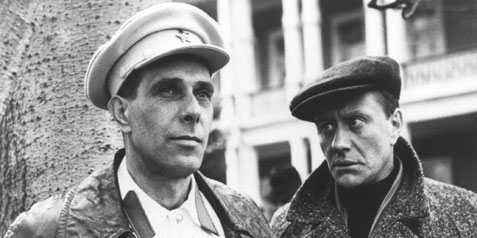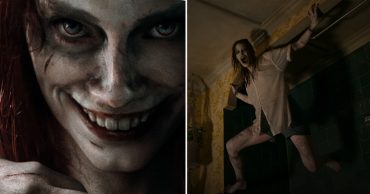
The contribution of the Soviet Union to cinema has been invaluable. Whether its the concept of the montage, popularised by Eisenstein and Vertov, the long takes of cinematographer Sergey Urusevsky, or the moody slow-cinema of Andrei Tarkovsky and Alexei German, no other nation outside from the USA, UK, Japan or France can claim to have contributed so much to the art-form.
To celebrate the contribution of the Soviet Union to cinema, we have created a list of our five favourites. All films on this list came after the death of Stalin in the 50s, whose era was characterised by simplistic propaganda movies meant to inspire the nation into action. The Nikita Khrushchev era, known as the thaw, brought significant reform in the arts, allowing artists a far wider range of artistic expression.
Additionally, while discussions of Soviet Cinema often bring to mind Andrei Tarkovsky and Sergei Eisenstein, there is a wealth of cinema, both comic, tragic and everything in between, apart from these two. We have opted not to include their films in favour of a broader, more original selection of classic Soviet Cinema which we hope will inspire you to discover more about the great work that came out of Russia during that time. Read on to see what we picked.
Welcome, Or No Trespassing
Whether it’s Georgiy Daneliya’s Seryozha, TV creations like Cheburashka, or the crazy adventures found in Mysteries of the Third Planet, the Soviet Union has been particularly adapt at making films about childhood that seem to come from the perspective of children themselves. The best of these is Elim Klimov’s Welcome, or No Trespassing, a raucous satire of Soviet life that takes place in a Young Pioneer camp.
It tells the story of a young boy, who upon being sent home from the camp, sneaks back in so he doesn’t have to face his grandmother. Bittersweet, endlessly inventive and truly childlike, it is as gently affecting as it is genuinely hilarious. Director Elim Klimov would go on to direct the far better known Come and See, which portrayed war from a child’s perspective, although we believe that this is the better film.
My Friend, Ivan Lapshin
A true Glasnost film, its remarkable that a film like My Friend, Ivan Lapshin was even made. Openly critical of the worst parts of the Stalin-era, it is a uniquely dreamlike portrayal of how the USSR came into being. Yet another Russian film told from the perspective of a young boy, it weaves the story of an acting troupe trying to put on a show with a criminal police investigator going after a gang of criminals. When the titular Lapshin falls in love with an actress, this world slowly unravels, keenly rendered in Alexei German’s unique directing style.
German’s long takes are iconic, with the camera floating elegiacally across the screen. It would prove a key influence upon the slow cinema movement, with echoes of it found across the work of filmmakers like Bela Tarr and Lav Diaz. Here there is great tenderness for the characters, even when it is certain that their belief in the future will be compromised, making the film as heartbreaking as it is gorgeously shot.
The Cranes are Flying
The first Russian war film to really explore the traumatic effects that World War II had upon the nation, The Cranes are Flying unites form and function unlike any other. Telling the story of Veronika, a woman left behind as her fiancé goes to fight in the Great Patriotic War (as Russia calls it), it details in heartrending fashion the way the war changed the nation forever.
Nearly fifty years before Jason Bourne, cinematographer Sergey Urusevsky pioneered the use of shaky cam to heighten human emotion. Long, bumpy takes follow Veronika as she rushes to finally say goodbye to her lover, or while waiting for him to return: making her the first real human protagonist of Soviet cinema, and possibly its most iconic. Rarely is a film so well-made and so emotionally devastating at the same time.
Walking The Streets of Moscow
Georgiy Danileya, mostly unknown in the West, is one of the Soviet Union’s true treasures. The Georgian-born director was known for his unique tragicomedies such as Mimino and Autumn Marathon that took a wry, askance view of human nature.
Walking The Streets of Moscow is one of his most delightful works. In both style and content it could fit neatly alongside the French New Wave, which saw its fruition during the 1960s. A positive view of Moscow and the possibilities that the city could bring, it remains an iconic portrayal of youth. One unfortunate scene aside, where the boys mercilessly mock an Orthodox priest, and Walking the Streets of Moscow reminds us that despite the Soviet Union’s problems, there was still space for portraying the happiness and lightness of youth.
War and Peace
It was reported at the time to be the most expensive movie of all time, a true epic to end all epics. While that figure turned out to be untrue, Sergei Bondarchuk’s War and Peace is a staggering achievement. The film, shot in 70mm, comes in at a huge seven hours, with thousands of soldiers employed from the government to play extras.
If that runtime sounds forbidding, don’t be alarmed. It is split into four parts, perfect to consume over a few evenings. What makes the film so remarkable is the equal weight it gives both to the war and peace parts of the book; the show-stopping action scenes are remarkably rendered while the quieter scenes, such as Natasha dancing to the Balalaika, are equally effective. While a lot of period dramas often fall under their own stuffiness, this one is thrillingly alive, using the full possibilities of the camera to capture the shifting moods of Leo Tolstoy’s epic historical novel.
Winner of Best Foreign Language Film in 1969, It has been remade countless times by Hollywood and the BBC. But they need not have tried. This is the definitive version of Leo Tolstoy’s novel.
 Follow Us
Follow Us





